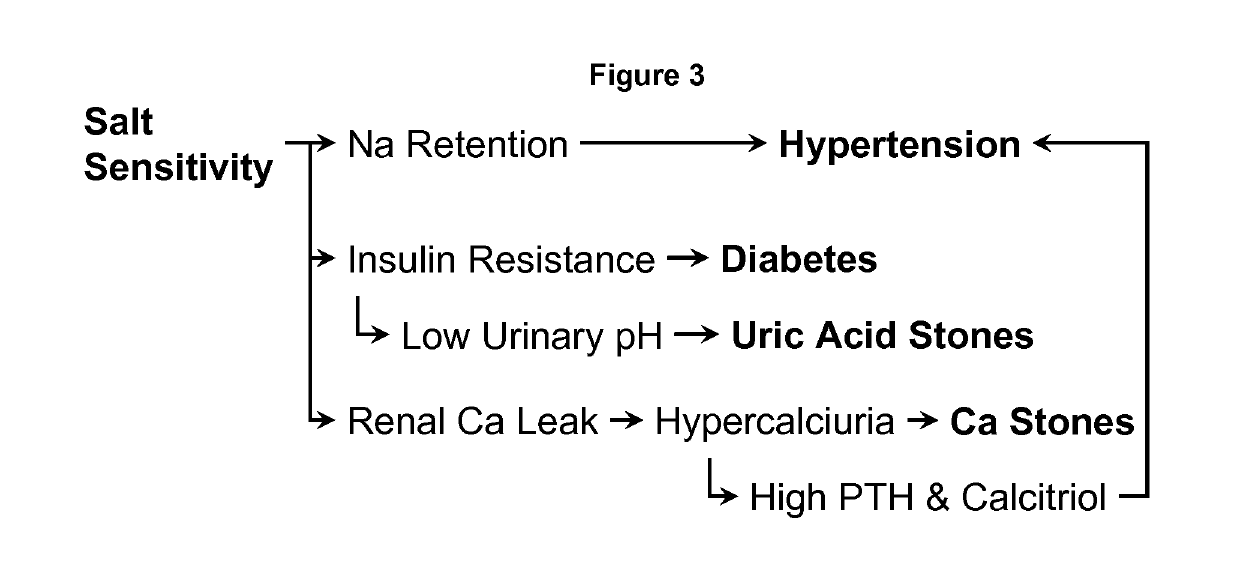Potassium-magnesium citrate as a surrogate of the DASH diet in managing hypertension
a technology of potassium magnesium citrate and dash diet, which is applied in the field of providing a dietary approach to stop hypertension (dash) diet, can solve the problems of prone to suffer from various metabolic disturbances of patients with essential hypertension, and achieve the effect of lowering blood pressure and convenient and safe management of essential hypertension
- Summary
- Abstract
- Description
- Claims
- Application Information
AI Technical Summary
Benefits of technology
Problems solved by technology
Method used
Image
Examples
example 1
Changes in Blood Pressure During KMgCitrate Treatment
[0075]In the recently published study by Odvina et al. (Am J Therap 13: 101-108, 2006) that examined the value of KMgCitrate in the prevention of thiazide-induced hypomagnesemia, the unpublished data on blood pressure were extracted. Twenty-one normal subjects participated in the trial. All were started on hydrochorothiazide 50 mg / day. Ten subjects took simultaneously KMgCitrate at a dose of 42 mEq K and 12 mEq Mg per day, while 11 subjects received potassium chloride (42 mEq / day). Supine blood pressures were taken before and each month for 5 months. FIG. 3 compares the systolic and diastolic blood pressures between the two groups.
[0076]There was a trend for systolic and diastolic blood pressures to decrease in both groups but the fall in both systolic and diastolic blood pressure was significant only in the KMgCitrate group. Thus, data suggested that KMgCitrate has a blood-lowering action beyond that of potassium chloride, which ...
example 2
Improvement of Insulin Responsiveness by KMgCitrate
[0077]In two subjects with uric acid stones, insulin responsiveness was determined before and after KMgCitrate treatment (49 mEq K, 24.5 mEq Mg per day for 4 weeks) by a hyperinsulinemic euglycemic pump procedure. During intravenous infusion of insulin, glucose was infused at a rate sufficient to maintain a constant glucose concentration. Insulin responsiveness was determined from the glucose disposal rate. The glucose disposal rate increased from 3.2 mg / m2 / min before KMgCitrate to 4.3 mg / m2 / min after KMgCitrate treatment in one patient. In the second patient, glucose disposal rate increased from 2.2 mg / m2 / min to 2.8 mg / m2 / min. Thus, KMgCitrate treatment improved insulin responsiveness, or rendered treated patients less insulin resistant.
[0078]KMgCitrate is expected to provide amelioration of other biochemical-physiological disturbances of metabolic syndrome when given to patients with essential hypertension as previously described ...
PUM
| Property | Measurement | Unit |
|---|---|---|
| molar ratios | aaaaa | aaaaa |
| peak time | aaaaa | aaaaa |
| molar ratio | aaaaa | aaaaa |
Abstract
Description
Claims
Application Information
 Login to View More
Login to View More - R&D
- Intellectual Property
- Life Sciences
- Materials
- Tech Scout
- Unparalleled Data Quality
- Higher Quality Content
- 60% Fewer Hallucinations
Browse by: Latest US Patents, China's latest patents, Technical Efficacy Thesaurus, Application Domain, Technology Topic, Popular Technical Reports.
© 2025 PatSnap. All rights reserved.Legal|Privacy policy|Modern Slavery Act Transparency Statement|Sitemap|About US| Contact US: help@patsnap.com


